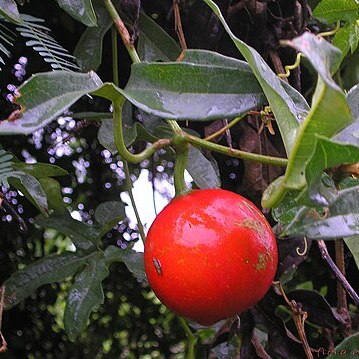Stems robust, branched, angular-striate, grooved, glabrous. Petiole ca. 5 cm, striate, glabrous, punctate; leaf blade adaxially deep green, broadly ovate-cordate, 12-13 × 12-13 cm, thinly leathery, shortly 3-lobed; lobes ovate-triangular, abaxially glabrous, adaxially hispidulous or punctate, margin undulate-denticulate, apex acute or shortly acuminate. Male raceme 12-15 cm; peduncle stout, striate and grooved, glabrous; pedicel short; bracts obovate-oblong, ca. 4 × 2-2.5 cm, cucullate, both surfaces white squamose or pubescent, margin dentate, apex obtuse; calyx tube narrowly funnelform, ca. 6 × 1 cm; segments narrowly lanceolate, ca. 1 × 0.3 cm. Female flowers and fruit not seen.
More
A pumpkin family plant. It is a vine or soft climber. It can grow 5-6 m long. The tendrils are divided into 3. The leave vary. They have 3-5 lobes and are heart shaped at the base. The lobes are oval and have teeth along the edge. Male and female flowers are separate. Male flowers are in groups of 5-10 and female flowers occur singly. The flowers are white and the corolla petals are wedge shaped and fringed. The fruit are round or oval. They turn red when ripe and have orange streaks.

